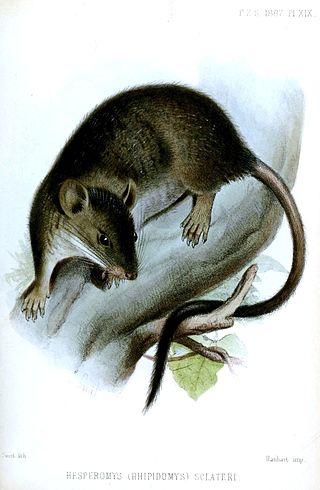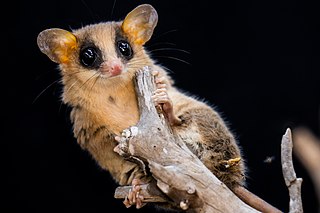
The rodent subfamily Sigmodontinae includes New World rats and mice, with at least 376 species. Many authorities include the Neotominae and Tylomyinae as part of a larger definition of Sigmodontinae. When those genera are included, the species count numbers at least 508. Their distribution includes much of the New World, but the genera are predominantly South American, such as brucies. They invaded South America from Central America as part of the Great American Interchange near the end of the Miocene, about 5 million years ago. Sigmodontines proceeded to diversify explosively in the formerly isolated continent. They inhabit many of the same ecological niches that the Murinae occupy in the Old World.
Sooretamys angouya, also known as the rat-headed rice rat, and Paraguayan rice rat, is a rodent species from South America. It is found in northeastern Argentina, southern Brazil and Paraguay in forested areas within the Atlantic Forest and cerrado. Since 2006, it has been classified as the only species in the genus Sooretamys; previously, it was included in the genus Oryzomys. Its taxonomic history has been complex, with the names Oryzomys angouya, Oryzomys buccinatus, and Oryzomys ratticeps in use for various parts of the species at different times. Some variation in its karyotype has been reported, with 2n = 80 to 82 and FN = 88 to 90.
Oligoryzomys stramineus, also known as the straw-colored colilargo or straw-colored pygmy rice rat, is a species of rodent in the genus Oligoryzomys of the family Cricetidae. It occurs only in the cerrado and caatinga ecoregions of northeastern Brazil. Its karyotype has 2n = 52 and FNa = 68-70.
The Tocantins vesper mouse is a South American rodent species of the family Cricetidae. It is found in Brazil. Its karyotype has 2n = 46 and FNa = 66.
The cerrado mouse is a rodent species from South America. It is found in the cerrado of Brazil.
The hairy-eared cerrado mouse or hairy-eared akodont, is a rodent species from South America. It is found in the cerrado grassland of Brazil.

Rhipidomys is a genus of rodents in the family Cricetidae, The following 25 species of climbing mouse species are currently recognised:
Wiedomys is a genus of South American rodents in the family Cricetidae.
Nectomys rattus, the small-footed bristly mouse, Amazonian nectomys, Amazonian mouse, or common water rat is a species of rodent in the genus Nectomys of family Cricetidae. It is found in Brazil, Colombia, French Guiana, Guyana, Suriname, and Venezuela, where it lives in a variety of habitats including lowland tropical rainforest, cerrado and caatinga. It is mainly found in areas close to water. It was recognized as distinct only in 2000 and its limits with other Nectomys, including Nectomys apicalis and Nectomys squamipes, remain unclear.
Oligoryzomys andinus, also known as the Andean colilargo or Andean pygmy rice rat, is a species of rodent in genus Oligoryzomys of family Cricetidae. It is found in the Andes of southern Peru and western Bolivia, but may in fact include more than one species. Its karyotype has 2n = 60 and FNa = 70.
Oligoryzomys magellanicus, also known as the Patagonian colilargo and the Magellanic pygmy rice rat, is a species of rodent in the genus Oligoryzomys of the family Cricetidae. It is found in the southernmost parts of Argentina and Chile, including Tierra del Fuego and other outlying islands. Its karyotype has 2n = 54 and FNa = 66.

Gracilinanus is a genus of opossum in the family Didelphidae. It was separated from the genus Marmosa in 1989, and has since had the genera Cryptonanus, Chacodelphys, and Hyladelphys removed from it.
Oecomys catherinae, also known as the Atlantic Forest oecomys, is a species of rodent in the genus Oecomys from eastern Brazil.

Cerradomys is a genus of oryzomyine rodents from eastern Bolivia, Paraguay, and central Brazil found in cerrado, Caatinga and Gran Chaco habitats.
The Paraguayan bolo mouse or Paraguayan akodont is a species of rodent in the family Cricetidae. According to the IUCN, it is present in Bolivia, Paraguay, and Peru, and possibly also in Argentina and Brazil. It is found at elevations from 300 to 2,030 m in a variety of habitats, including cerrado, chaco, and heath pampas.
Oligoryzomys moojeni is a species of rodent from South America in the genus Oligoryzomys of family Cricetidae. It is known only from central Brazil, where it is found in the cerrado and gallery forests. It is named after twentieth-century Brazilian zoologist João Moojen. Its karyotype has 2n = 70 and FNa = 84.

The cerrado climbing mouse or long-tailed rhipidomys is an arboreal rodent species in the family Cricetidae from South America. It is found in primary or secondary forests of the cerrado and caatinga in central and eastern Brazil, and has also been seen in the Atlantic Forest. Its karyotype is 2n = 44, FN = 48-52. They are nocturnal animals and can be found in both tree canopies and on the ground.
The caatinga vesper mouse is a rodent species in the family Cricetidae from South America. It is endemic to eastern Brazil, where it is found in open savanna (cerrado) and thorny scrub (caatinga) habitats. Its karyotype has 2n = 66 and FN = 68. It was formerly synonymized with C. callosus, but the latter has 2n = 50 and FN = 66. Karyologic analysis of C. expulsus has shown that the X chromosome is large and submetacentric while the Y chromosome is either acrocentric or submetacentric. Predators include the barn owl. Sexual dimorphism in shape and size occurs; the former is present mainly before the age of 20 days. Males are smaller before age 50 days and larger thereafter, which becomes less prominent after 200 days.
Cerradomys scotti, also known as Lindbergh's oryzomys, is a rodent species from South America in the genus Cerradomys. It is terrestrial and is found in the cerrado (savanna) ecozone of south central Brazil, Bolivia and Paraguay. The species is common and appears to tolerate a degree of agricultural habitat modification.
The eastern Amazon climbing mouse is a rodent species from South America. It is endemic to central Brazil, where it is found in the eastern fringe of the Amazon rainforest, as well as in gallery forest and tropical dry forest within the cerrado ecoregion. It is often found in areas under cultivation.




